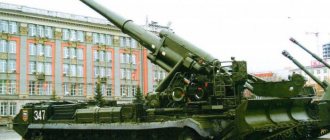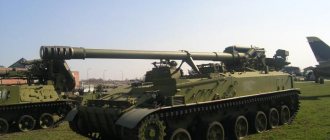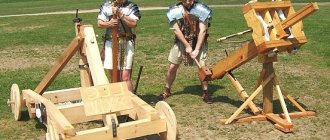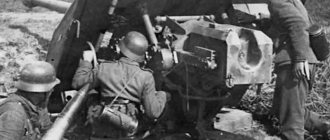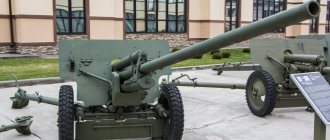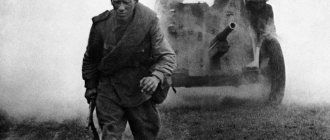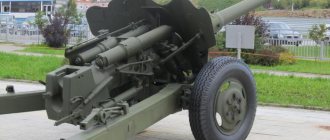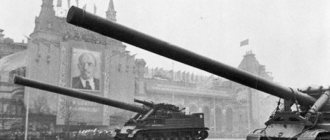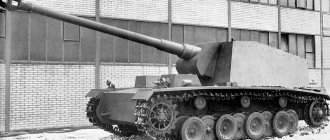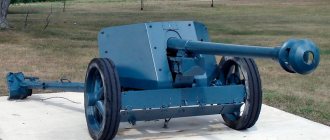Home » Tanks of the present and future » 2S25 “SPRUT-SD” - what is it, a tank or a self-propelled gun?
Tanks of the present and future
boroda 05/20/2019 2294
15
in Favoritesin Favoritesfrom Favorites 7
But when you mention a self-propelled anti-tank gun, you immediately think of tank destroyers from the war, such as the Hetzer or SU-100. Naturally, this machine has nothing in common either in philosophy or in tactics of use with the above-mentioned self-propelled guns.
But no matter what this machine is called, the device is truly wonderful. And, in my opinion, it has a wide range of applications and a great future. By the way, despite the fact that Sprut-SD is already entering service with the troops and taking part in exercises, it is still in experimental use. I wonder if the military is still wondering whether they need such a machine or not?
History of creation
The 2S25 Sprut-SD self-propelled anti-tank gun was created in the early 90s. on the extended (two rollers) base of the BMD-3 airborne combat vehicle by the Volgograd Tractor Plant joint-stock company, and the artillery unit for it - at the artillery plant No. 9 (Ekaterinburg). In contrast to the Sprut-B towed artillery system, the new self-propelled gun was named Sprut-SD (“self-propelled”, “landed”).
Initially intended for the Airborne Forces and designed for parachute landing with a crew from an Il-76 military transport aircraft, the gun is currently being offered to the Marine Corps to provide anti-tank and fire support during landing operations.
One of its first performances took place on May 8, 2001 at the Prudboy tank training ground of the North Caucasus Military District for representatives of the Russian power ministries and the foreign military-diplomatic corps from 14 foreign countries in Southeast Asia, the Middle East, Africa and South America.
Purpose
The 125-mm self-propelled anti-tank gun 2S25 "Sprut-SD" is designed to destroy enemy vehicles, including armored ones, and manpower when operating as part of units of ground and airborne forces, as well as marines.
Outwardly, it looks like a regular tank and combines the capabilities of a landing amphibious assault vehicle with a main battle tank. Externally, the Sprut-SD is no different from a conventional tank and has no analogues abroad.
Under what conditions is it used?
“Sprut-SD” is able to cover distances of at least 500 kilometers without refueling. Transportation of self-propelled guns is carried out by military transport aircraft. Landing ships can also be used for this purpose. For landing the installation, its developers provide landing and parachute methods. The crew of the combat vehicle is located in its cockpit. Having a high power density, the Sprut-SD is suitable for combat operations both in high mountains and in hot tropical climates.
The self-propelled gun is capable of resisting the enemy’s highly armored vehicles, fortified strongholds and manpower. Overcoming water obstacles is possible provided that the excitement does not exceed 3 points. The artillery mount can operate on water due to water-jet engines equipped on the chassis. The buoyancy of the installation is ensured using water jets with impellers with a diameter of 34 cm and support rollers. The design of the self-propelled guns has closed air chambers. When water enters the housing, pumping is carried out using powerful water pumps. While afloat, the Sprut-SD can fire.
After completing its combat mission, the self-propelled gun is adapted to carry out independent loading from the water surface into a landing ship.
Snowmobile tracks and asphalt boots are used especially for working in snowy areas. “Sprut-SD” is suitable for areas that have received radiation, chemical and biological contamination. The safety of the crew is ensured by protection from weapons of mass destruction.
A combat artillery vehicle can camouflage itself using a smoke screen. For this purpose, the designers mounted brackets (2 pieces) on the rear plate of the self-propelled gun turret, in which six 902B grenade launchers using 81 mm caliber smoke grenades are located.
Key Features
According to experts, the new self-propelled gun, in appearance and firepower, is comparable to a tank, is characterized by the maneuverability of the airborne BMD-3 and has no analogues abroad. In addition, the Sprut-SD is equipped with a unique hydropneumatic chassis, which allows the combat vehicle to move smoothly and quickly in off-road conditions at speeds of up to 70 km per hour, which significantly improves the conditions for firing while on the move.
In addition, Sprut-SD is capable of overcoming water obstacles at afloat speeds of up to 10 km per hour. This was confirmed by tests in the North Sea, when during a storm of up to 3 points the BM confidently fired at the designated targets. The vehicle can parachute from cargo ships onto the water surface and independently return to the ship. The noted and other qualities, together with the circular rotation of the turret and the stabilization of weapons in two planes, allow the Sprut-SD to be used as a light amphibious tank.
What projectiles are used?
The combat vehicle's ammunition contains shells that can fire four types of shots:
- High-explosive fragmentation (20 shells).
- Armor-piercing (14 pieces). By firing armor-piercing discarding projectiles from a distance of two kilometers, it is possible to penetrate homogeneous armored steel, the thickness of which does not exceed 23 cm.
- HEAT shells (6 pieces). They penetrate homogeneous steel armor up to 30 cm thick.
- Equipped with anti-tank guided missiles. They penetrate armor whose thickness exceeds 35 cm.
General device
The BM hull is divided into a control compartment (front part), a fighting compartment with a turret (middle part) and an engine and transmission compartment (aft part).
In the stowed position, the vehicle commander is to the right of the driver, and the gunner is to the left. Each crew member has observation devices with day and night channels built into the roof. The commander's combined sight is stabilized in two planes and combined with a laser sight to guide 125 mm projectiles along a laser beam. The gunner's sight with a laser rangefinder is stabilized in the vertical plane.
125 mm smoothbore gun 2A75
This weapon is the main armament of the Sprut-SD self-propelled gun. The gun was created on the basis of the 125-mm 2A46 tank gun, which is installed on T-72, T-80 and T-90 tanks. When installed on a lighter chassis, the gun was equipped with a new type of recoil device, providing a recoil of no more than 700 mm. The high-ballistic smoothbore gun installed in the fighting compartment is equipped with a computerized fire control system from the commander's and gunner's workstations, which are functionally interchangeable.
As an auxiliary weapon, the Sprut-SD self-propelled gun is equipped with a coaxial 7.62-mm machine gun with an ammunition load of 2,000 rounds loaded into one belt.
The gun without a muzzle brake is equipped with an ejector and a thermal insulating casing. Stabilization in the vertical and horizontal planes makes it possible to fire 125 mm separate-case-loading ammunition. "Sprut-SD" can use all types of 125-mm domestic ammunition, including armor-piercing sub-caliber finned projectiles and tank ATGMs. The gun's ammunition load (40 125-mm rounds, of which 22 are in the automatic loader) can include a laser-guided projectile, which can hit a target located at a range of up to 4000 m. The gun can fire afloat in waves up to 3 points in a sector of ±35 degrees, maximum rate of fire - 7 rounds per minute.
The horizontal autoloader of the carousel-type gun is installed behind the vehicle's turret. It is a set of components and mechanisms - a rotating conveyor with 22 shots ready for immediate use, a chain mechanism for lifting a cartridge with a shot, a mechanism for removing spent pallets with a catcher, a chain rammer for a shot from a cartridge into a gun, a drive for the cartridge ejection hatch cover and a movable tray, electromechanical gun stopper at the loading angle, control unit. Cassettes, with shells and charges placed separately in them, are installed in the automatic loader conveyor at an angle equal to the gun loading angle. When loading, a projectile is first fed into the breech of the gun, then a propellant charge in a semi-combustible cartridge case. If the automatic loader fails, the gun can be loaded manually.
To ensure increased recoil, the automatic loader has an extended cassette lift frame. The mechanism for catching and removing spent pallets makes it possible, when a spent pallet passes through it, to temporarily block the back side of the end part of the gun breech. This allows the cleaning system to blow air through the gun breech area and crew positions using a rotating device during the subsequent movement of the spent pallet. At the bottom of the fighting compartment there is an automatic loader conveyor rotating around a vertical axis, allowing crew members to move inside the vehicle from the fighting compartment to the control compartment and back along the sides of the hull.
Fire control system
Includes a gunner's sighting system (night and day sights with vertical stabilization of the field of view, digital ballistic computer, laser rangefinder); commander's sight combined with the function of a day/night sight with a laser range finder and a stabilized field of view in two planes, as well as a target guidance device for guided missiles of the 9K119M complex; a set of sensors for automatically entering corrections taking into account atmospheric parameters, charge temperature, wear and curvature of the barrel, etc.
A computerized fire control system from the commander’s workplace provides observation of the terrain with a stabilized field of view, target search and target designation using the optical system of the commander’s sight; combining the functions of launching and controlling a missile with targeted firing of artillery shells in the commander’s sight; duplication of the ballistic computing device of the gunner's instrument complex; autonomous activation and control of guidance drives and gun automatic loader; prompt transfer of control of the complex from the gunner to the commander and vice versa.
Powerplant and chassis
They have much in common with the BMD-3, the base of which was used in the development of the 2S25 Sprut-SD self-propelled gun. The 2B06-2S multi-fuel diesel engine installed on it with a maximum power of 510 kW is interlocked with a hydromechanical transmission, a hydrostatic turning mechanism and power take-off for two water-jet propulsors. The automatic transmission has five forward gears and the same number of reverse gears.
Individual, hydropneumatic, with adjustable ground clearance from the driver's seat (in 6-7 seconds from 190 to 590 mm) chassis suspension ensures high cross-country ability and a smooth ride. The chassis on each side includes seven single-pitch rubber-coated road wheels, four support rollers, a rear drive wheel and a front idler wheel. There is a hydraulic mechanism for tensioning steel, double-ridge, lantern-mounted tracks with a rubber-metal hinge, which can be equipped with asphalt shoes.
When making marches of up to 500 km, the vehicle can move on the highway at a maximum speed of up to 68 km/h, and on dry dirt roads at an average speed of 45 km/h.
Two water-jet propulsors allow the 2S25 self-propelled gun to move through water at speeds of up to 10 km/h. To increase buoyancy, the vehicle is equipped with support rollers with closed air chambers and powerful water pumps that pump water out of the hull. The vehicle has good seaworthiness and can operate effectively afloat, including conducting targeted fire in the forward sector of fire at 70 degrees, with seas of 3 points.
In addition to the above, the standard equipment of the vehicle includes a system of protection against weapons of mass destruction and a set of night vision devices.
The Sprut-SD self-propelled gun can be transported by military aviation aircraft and landing ships, parachuted with a crew inside the vehicle, and overcome water obstacles without preparation.
Setting up a workplace for the commander
At the main crew's workplace, the designers of the artillery installation provide for the presence of the following devices:
- daytime monocular periscope sight 1A40-M1, which has a stabilizing field of view;
- night optical-electronic complex TO1-KO1R;
- a laser rangefinder, with the help of which the commander measures the distance to the target and develops a lead angle while firing at a moving target;
- information channel, with the help of which the guidance and launch of a guided missile is carried out;
- a backup ballistic and sighting device used by the gunner;
- a special remote control that provides autonomous control of the automation during loading;
- drives providing operational communication between the commander and gunner.
Interesting
The armies of many countries around the world have recently paid special attention to lightly armored military equipment as the basis of rapid reaction forces. The fight against international terrorism and conducting peacekeeping operations in local conflict zones required the creation of highly mobile and functionally flexible “combat systems of the future.”
In this regard, according to foreign experts, it is Russia that has the greatest capabilities in the field of creating lightly armored landing equipment. The Armed Forces of the Russian Federation are already equipped with effective models of light (up to 18 tons), highly cross-country, air transportable armored vehicles, capable of performing tasks autonomously, in isolation from the main forces and rear units, as well as in any conditions (including in hard-to-reach and remote areas, in mountainous terrain, in desert conditions and on the coast).
In addition, according to experts, this class of combat vehicles has significant export potential. It is these vehicles that can be used as the basis for equipping the mobile component of the armed forces and intelligence services of any state.
The validity of this opinion is confirmed by the Sprut-SD self-propelled gun. After its demonstration at the training ground, many military attaches admitted that in terms of combat and operational capabilities it surpasses all existing foreign analogues. Thus, not a single vehicle in the world can be used in the mountains at an altitude of up to 4000 meters, change the ground clearance by 400 mm, sail when the sea state is up to 3 points, go on and off from the water to a landing ship and land with the crew.
Representatives of the armed forces of the Republic of Korea, India and other countries showed great interest in the 2S25 Sprut-SD self-propelled artillery mount.
What tasks does the crew commander perform?
The leader of the group monitors the area using night and day vision sights. The commander of this self-propelled artillery installation, regardless of the gunner, can carry out targeted shooting from both a machine gun and a cannon. This opportunity is provided by a computerized fire control system: if the initial data is available, the tank ballistic computer uses drives to automatically enter angles and leads. Due to this function, the commander is not required to perform retargeting using rangefinder and aiming marks. The commander is free to fire.
Main tactical and technical characteristics of the 2S25 Sprut-SD self-propelled anti-tank gun
| Combat weight, t | 18 |
| Main dimensions, m: | |
| length (with gun) | 7,07 (9,771) |
| width | 3,152 |
| height (with wind sensor) | 2,72 (2,98) |
| Maximum speed, km/h: | |
| along the highway | up to 70 |
| on the ground | up to 49 |
| afloat | to 10 |
| Cruising range, km | 500 |
| Booking | Bulletproof |
| Sighting range, m | 4000 |
| Smoke screen installation tool | TDA, 6×902V “Cloud” |
| Booking | bulletproof |
| Crew, people | 3 |
Source - https://2drugavmeste.ucoz.net/index/sprut_sd/0-111
